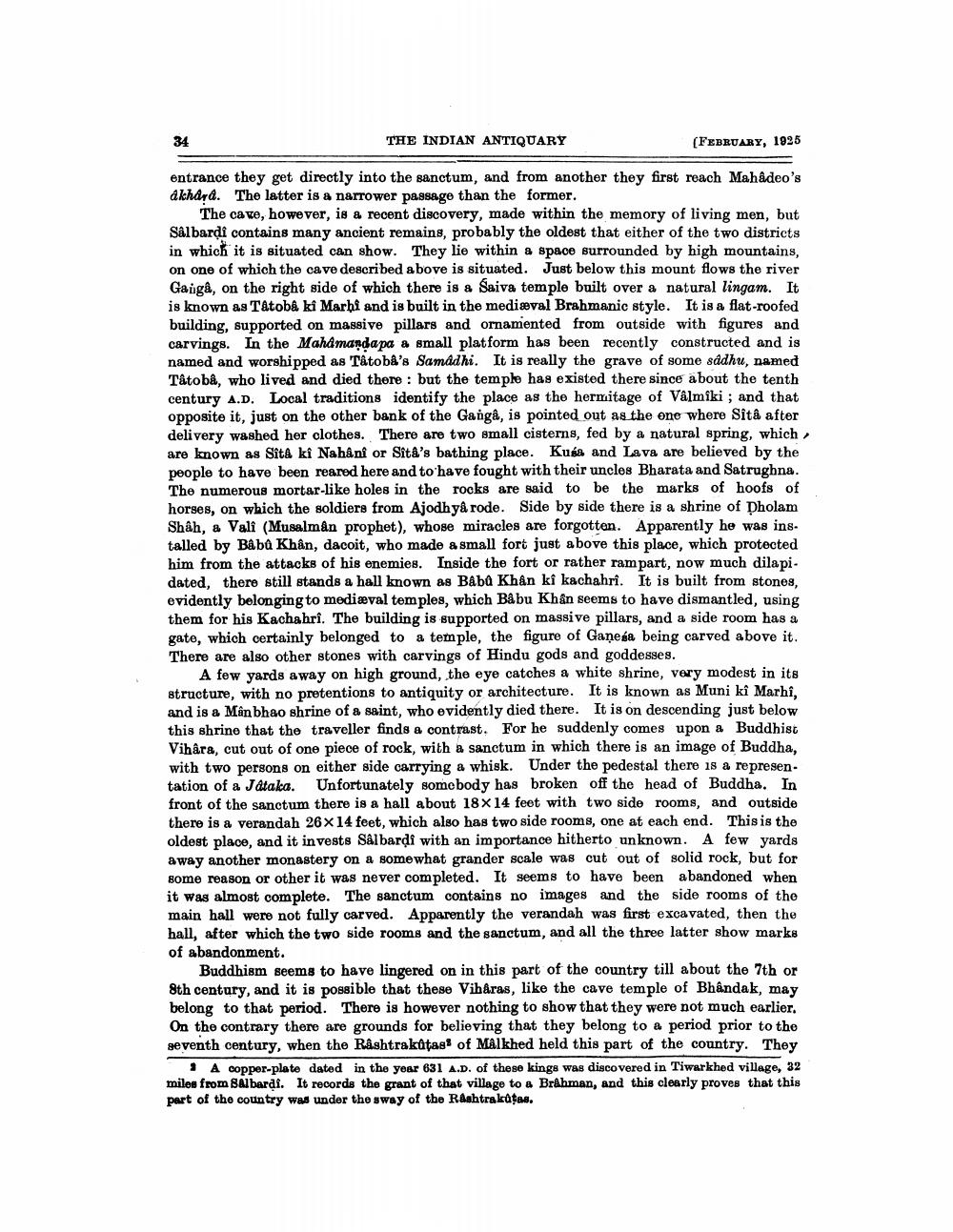________________
THE INDIAN ANTIQUARY
(FEBRUARY, 1925
entrance they get directly into the sanctum, and from another they first reach Mahadeo's akhard. The latter is a narrower passage than the former.
The cave, however, is a recent discovery, made within the memory of living men, but Sålbardi contains many ancient remains, probably the oldest that either of the two districts in which it is situated can show. They lie within a space surrounded by high mountains, on one of which the cave described above is situated. Just below this mount flows the river Gaiga, on the right side of which there is a Saiva temple built over a natural lingam. It is known as Tatoba ki Marhi and is built in the medieval Brahmanic style. It is a flat-roofed building, supported on massive pillars and ornamented from outside with figures and carvings. In the Mahamandapa a small platform has been recently constructed and is named and worshipped as Tåtoba's Samadhi. It is really the grave of some sadhu, named Tâtobân, who lived and died there : but the temple has existed there since about the tenth century A.D. Local traditions identify the place as the hermitage of Valmiki ; and that opposite it, just on the other bank of the Gangå, is pointed out as the one where Sitâ after delivery washed her clothes. There are two small cisterns, fed by a natural spring, which , are known as Sita ki Nahani or Sita's bathing place. Kuss and Lava are believed by the people to have been reared here and to have fought with their uncles Bharata and Satrughna. The numerous mortar-like holes in the rocks are said to be the marks of hoofs of horses, on which the soldiers from Ajodh ya rode. Side by side there is a shrine of Dholam Shâh, a Vali (Musalman prophet), whose miracles are forgotten. Apparently he was ins. talled by Babů Khân, dacoit, who made a small fort just above this place, which protected him from the attacks of his enemies. Inside the fort or rather rampart, now much dilapi. dated, there still stands a hall known as Baba Khan ki kachahri. It is built from stones, evidently belonging to medieval temples, which Babu Khân seems to have dismantled, using them for his Kachahri. The building is supported on massive pillars, and a side room has a gate, which certainly belonged to a temple, the figure of Ganesa being carved above it. There are also other stones with carvings of Hindu gods and goddesses.
A few yards away on high ground, the eye catches a white shrine, very modest in its structure, with no pretentions to antiquity or architecture. It is known as Muni ki Marhi, and is a Mân bhao shrine of a saint, who evidently died there. It is on descending just below this shrine that the traveller finds a contrast. For he suddenly comes upon a Buddhist Vihara, cut out of one piece of rock, with a sanctum in which there is an image of Buddha, with two persons on either side carrying a whisk. Under the pedestal there is a representation of a Jataka. Unfortunately somebody has broken off the head of Buddha. In front of the sanctum there is a hall about 18X 14 feet with two side rooms, and outside there is a verandah 26 X 14 feet, which also has two side rooms, one at each end. This is the oldest place, and it invests Salbardi with an importance hitherto unknown. A few yards away another monastery on a somewhat grander scale was cut out of solid rock, but for some reason or other it was never completed. It seems to have been abandoned when it was almost complete. The sanctum contains no images and the side rooms of the main hall were not fully carved. Apparently the verandah was first excavated, then the hall, after which the two side rooms and the sanctum, and all the three latter show marks of abandonment.
Buddhism seems to have lingered on in this part of the country till about the 7th or 8th century, and it is possible that these Vihåras, like the cave temple of Bhandak, may belong to that period. There is however nothing to show that they were not much earlier. On the contrary there are grounds for believing that they belong to a period prior to the seventh century, when the Rashtrakūtass of Malkhed held this part of the country. They
1 A copper-plate dated in the year 631 A.D. of these kings was discovered in Tiwarkhed village, 32 miles from Albardi. It records the grant of that village to a Brahman, and this clearly proves that this part of the country was under the sway of the Rashtrakatas.




